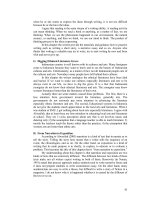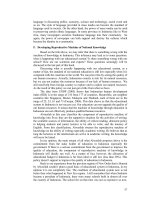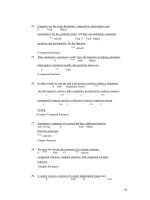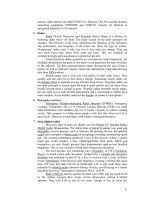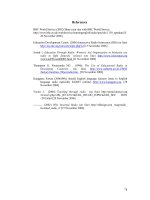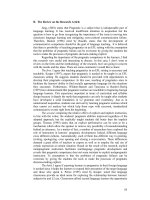Learning japanese hiragana and katakana takagaki and henshall 1990
Bạn đang xem bản rút gọn của tài liệu. Xem và tải ngay bản đầy đủ của tài liệu tại đây (41.71 MB, 146 trang )
·
TUTTLE
Learning
Japanese
e
Ira
ana
and
a a
ana
Learning Japanese
Hiragana
and Katakana Learning Japanese
Hiragana
andKatakana
(WORKBOOK
AND
PRACTICE
SHEETS)
Takagaki
&
Henshall
TUTTLE
PUBLISHlNG
Tokyo · Rutland, Ve
rmont
· Singapore
Published
by
Tuttle Publishing, an imprint
of
Periplus Editions (HK) Ltd., with editorial offices at
61
Tai Seng Avenue, #02
-1
2 Singapore 534167 and 364 Innovation Drive, North Clarendon, Vermont 05759 U.S.A.
Copyright © 1990 by Charles E. Tuttle Publishing Company, Inc.
All rights reserved.
LCC Card No. 90-70374
ISBN-IO: 0-8048-3815-1
ISBN-13: 978-0-8048-3815-3
Previously published in 2005 as
A Guide
to
Learning Hiragana & Katakana ISBN 0-8048-3391-5
First edition, 1990
Printed
in
Singapore
Distributed by:
North America, Latin America
and
Europe
Tuttle Publishing
364 Innovation Drive,
North Clarendon,
VT
05759-9436, USA
Tel
: (802) 773 8930
Fax: (802) 773 6993
E-mail:
www.tutt1epublishing.com
Japan
Tuttle Publishing
Yaekari Building, 3rd Floor,
5-4-12 Osaki, Shinagawa-ku,
Tokyo 141-0032
Tel
: (03) 5437 0171
Fax: (03) 5437 0755
E-mail:
Asia
Pa
cific
Berkeley Books Pte Ltd
61
Tai Seng Avenue #02-12
Singapore 534167
Tel
: (65) 6280 1330
Fax: (65) 6280 6290
E-mail:
www.periplus.com
II
10
09 08
10
9 8 7 6 5 4 3
T U
TT
L E
PU
B
Ll
S H I N G ®
is
a registered trade
mark
of Tuttle Publishing, a division of Periplus Editions (HK) Ltd.
CONTENTS
How to Use This Book 7
An Explanation
of
Kana 9
PART
I:
HIRAGANA
17
Practice a -
ko
19
Mini Review a -
ko
24
Practice
sa
- to
26
Mini Review sa - to
31
Practice
na
-
ho
33
Mini Review
na
-
ho
38
Practice
rna
- yo 40
Mini Review
rna
- yo 44
Practice ra - n
46
Mini Review ra - n 50
Voiced and Half-Voiced Sounds 52
Review
of
Voiced and Half-Voiced Sounds
54
Review
of
Double Vowels and Consonants
57
Combined Sounds
59
Review
of
Combined Sounds
61
Review through Place Names and Period Names
63
General Review
65
PART II:
KATAKANA
69
Practice a - to
71
Mini Review a - to
81
Practice
na
- n
83
Mini Review na - n 96
Voiced and Half-Voiced Sounds
98
Review of Voiced and Half-Voiced Sounds 100
Combined Sounds 102
Review of Combined Sounds and Double Consonants 104
Review through International Place Names 106
PART
nl:
FINAL REVIEW
About Japan
Food Items Quiz
Rora
and Fauna Quiz
Personal Names Quiz
Kana Word Search
Quiz Answers
Do-It-Yourself Kana Charts
The
Iroha Verse
6
109
111
113
114
115
116
117
118
120
HOW
TO
USE
THIS
BOOK
The main aim
of
this book is to help students achieve competence in reading and writing
kana, the phonetic symbols that are fundamental to written Japanese. The book starts with
a section entitled An Explanation
of
Kana, which contains everything the student will need
to know about the two
kana systems
of
hiragana and katakana. Part I
of
the workbook sec-
tion then systematically introduces each
hiragana symbol, voiced form, and combination,
and provides ample practice and review. Part II does the same for
katakana, while Part III
provides an overall review.
The Explanation
of
Kana outlines the function and origin
of
kana, the difference between
the two
kana systems, the various sounds, the combinations, and the conventions
of
usage.
It attempts to be detailed and thorough so that it can be used for reference at any stage.
Though all the information about
kana is grouped together in this one section for ease
of
reference,
it
is not expected that the student will read it all before starting on the practice
pages.
In fact, to do so might give the impression that kana are perhaps rather formidable,
which is not really the case at all. (Just ask any Japanese child!) We recommend that the
student start work on the
hiragana practice pages after reading the first three subsections -
on the function, origin, and basic sounds
of
kana. After fmishing practice
of
the forty-six
basic
hiragana symbols the student should go back to the Explanation and read the subsec-
tion on additional sounds, then work through the rest
of
the hiragana practice pages before
moving on to the
katakana practice. The final subsection, on other points to note, is mostly
concerned with special
katakana combinations and can be left until the appropriate point in
the
katakana practice pages, just prior to the final review. Students may modify this order,
but we recommend fmishing practice
of
one kana system before moving on to the next.
In the practice pages
of
Parts I and II each kana symbol is allotted half a page, permitting
plenty
of
writing practice in the boxes given. We suggest working in pencil, rather than
ink, as this will allow for erasing and repeated use. Stroke order and a pronunciation guide
are also given for each symbol. In addition, for each symbol there is an illustration
of
its
graphic evolution from its "parent" character (see Explanation
of
Kana) and a reference
number for that character as
it
occurs in A Guide to Remembering Japanese Characters
(Charles E. Tuttle Company, 1988), together with the character's pronunciation. This may
be
of
interest to readers wishing to continue their studies
of
written Japanese to an advanced
level. (However, some
of
the original characters are no longer commonly used and there-
fore are not included
in
A Guide
to
Remembering Japanese Characters.)
7
After approximately every ten symbols there are "mini review" pages for further practice,
this time using whole words. These are cumulative, containing symbols not only from the
group just completed but from earlier groups. The mini reviews can be used purely for
copying practice, or, by covering the cue
kana on the left side
of
the page, as more chal-
lenging writing exercises. They can also be used as vocabulary exercises.
Part III, the Final Review, contains exercises, quizzes, and "do-it-yourself' charts. Unlike
the reviews
in the fIrst two parts it combines the two kana systems, as is natural in Japanese
texts. And for a more natural effect the boxes used earlier in the book to help achieve even
spacing and proper stroke lengths are dispensed with in this fInal part.
The words appearing in the reviews have been carefully chosen in keeping with an addi-
tional aim
of
this book, which is to expose readers to key words related to Japanese society
and culture. The prime criterion for selecting review words was their suitability for practic-
ing the
kana symbols, but we thought it would be helpful to students
if
in addition these
words could, whenever possible, have particular relevance to Japanese culture. About half
of
the 450
or
so vocabulary items in the book fall into this category. It is beyond the scope
of
the book to explain these in detail, but students who take the trouble to fInd out more
about them will be rewarded with a broadened appreciation
of
Japan's society and culture.
In short, we intend that these words should
be
used as a sort
of
checklist for
an
exploration
of
Japan, rather than simply memorized as isolated vocabulary items.
Readers will occasionally encounter a semicolon between English equivalents given for a
Japanese review word. This indicates that the Japanese word is a homophone, that is, a
word having a different meaning but the same sound as another. Normally these homo-
phones would be written with different characters, but when expressed in phonetic
kana
script or romanization such differentiation is not possible. The English words separated by
a semicolon thus refer to different Japanese words sharing the same
kana form. (Commas
between English words simply indicate nuances
of
the same word.) It should also
be
noted
that there is sometimes a subtle difference
in
intonation between "homophones," which can-
not be determined from the
kana or romanization.
Finally, readers are advised to seek specialist or native-speaker guidance on intonation and
pronunciation. It should be appreciated that the pronunciation guides given in this book can
only ever be approximate, owing to the variety in pronunciation
of
the same English word
in different parts
of
the world. Also, some Japanese sounds cannot be precisely represented
by English letters. The Japanese "r," for example, actually falls between the English
"r"
and
"d"
But remember that, with both speaking and writing, practice makes perfect!
8
AN
EXPLANATION
OF
KANA
The Function of
Kana
Kana are purely phonetic symbols. That is, they are written representations
of
pronuncia-
tion. They can express the entire Japanese language in writing, though in practice the writ-
ten language uses a mixture
of
kana and kanji (characters taken from Chinese).
There are two
kana systems: katakana and hiragana. Katakana is now mainly used for
words taken from languages other than Chinese.
Hiragana is the more important
of
the two
systems, and is used for everything not written
in
katakana or kanji. Kanji show meanings
of
words, though they also have pronunciations. Normally they are used for nouns and the
the unchanging part (the stem)
of
verbs, adjectives, and
adv~rbs,
while hiragana symbols
are used for the changing parts (notably endings). For example, the verb
iku means "go,"
while
ikanai means "not go." The stem is i-, and this is usually written with a kanji, while
the variable endings
-ku and -kanai are written in hiragana. Hiragana is also used to \\rite
particles, and other words where
kanji are not appropriate. To all intents and purposes the
two
kana systems are not interchangeable, and are rarely mixed within a given word. The
rule is:
katakana for non-Chinese loan words, hiragana and kanji for the rest.
The student
of
Japanese should ideally aim to learn all the two thousand kanji in common
use. They
playa
very practical role in graphically and distinctively conveying the meaning
of
a written statement, unlike a purely phonetic script, and thereby aid rapid understanding.
And naturally, no one can expect to read unedited Japanese texts without a knowledge
of
kanji. However, learning the kanji is a time-consuming task. Many
of
them are structurally
complex, and many have a wide range
of
meanings and pronunciations.
Kana, on the other hand, are much fewer in number, with only forty-six basic symbols in
each
of
the two systems. They are simple to write, and, with very few exceptions, they
have fixed pronunciations.
If
you don't know the kanji for a particular word, but know the
pronunciation, you can just express that entire word
in
kana (hiragana, that is; remember
that
katakana is for non-Chinese foreign words). In other words, while not ideal, kana
(hiragana)
can substitute for kanji. This means that even beginners can express
themselves
in
functional written Japanese with relatively little effort.
9
The Origin of
Kana
The word kana derives from karina, meaning "borrowed name," for the
kana
symbols are
simplified forms
of
certain borrowed Chinese characters used for their sound (though, con-
fusingly, the same characters lent their meaning in other contexts). The prefix
hira-
means
"ordinary," with connotations
of
"informal" and "easy," and in this particular case
"cursive." Thus
hiragana means "ordinary (cursive)
kana,"
and indeed hiragana has tradi-
tionally been the more commonly used
of
the two systems, and the more cursive. The
hira-
gana
symbols are simplifications
of
whole Chinese characters. For example, the
kana
~
(pronounced like the "a" in "car") derives from a cursive rendition
of
the character
~
(pronounced "an").
Kata-
means "one side" or "partial," pointing to the fact that katakana
symbols derive from one part
of
a Chinese character. For example,
~
(pronounced like
"ee" in "meet") is the left-hand part
of
the character
1t
(also pronounced "ee").
Both systems evolved around the end
of
the eighth century. In those early days hiragana
was used mostly by women, while men preferred to use the more angular katakana. How-
ever, these associations have long since disappeared.
The Basic Sounds Represented
by
Kana
Kana
symbols basically represent syllables, and the
kana
systems are therefore syllabaries
rather than alphabets. Generally the syllables are crisp and clear combinations
of
one con-
sonant and one following vowel, or one vowel by itself. There is only one consonant that
exists as a syllable and
kana symbol in its own right,
n.
The use
of
English letters to refer to Japanese sounds and symbols can produce a number
of
apparent irregularities. Among other things a combination
of
consonant and vowel in
Japanese will not necessarily have the same pronunciation as in English.
For
example,
while
",~,
is found in the h group (see the table that follows), its pronunciation is actually
closer to the English sound "fu" than "hu." To facilitate pronunciation the romanization
used in this book is a version
of
the Hepburn system, which transcribes
~~,
asfu rather
than
hu,
but readers should appreciate that there is no direct equivalent in Japanese to an
English "f." Similar cases
of
convenient but seemingly irregular romanization are found in
the
s group and t group. This may begin to seem complicated, but in fact correspondence
in Japanese between
kana
spelling and pronunciation is much simpler than in the case
of
English and its alphabet. Attempts to express certain loan words in katakana can seem
10
awkward, but that is really a problem relating to the Japanization
of
non-Japanese words,
rather than to the
kana system itself.
Each
of
the two kana systems contains the same basic forty-six syllables, arranged in the
same order. The basic syllabaries are
as
follows (combined for convenience, with the kata-
kana
written slightly smaller).
VOWELS
a
1
U
e 0
J\
-p
Ii"
,
t7
;t
:I-
;h~
;t
\"
\
1
a
1
u
e
0
k
1)\
tJ
~
~
<
I]
~t
'
1
,
.:l
ka
ki
ku
'
ko
s
~
,
l
'l
er-
A
1:t
,tz
Yc
'/
"-
sa shi
su
se
so
t
(2
~-
-J?
~
-:J
\\I
"1
_.::r-_
t
l-
tI)
~
ta
chi
tsu
te
to
t-
-t-
-
)l.
;t
)
n
t:
-
t/J
tJ
(f)
z
0
d-
na
ni
nu
ne no
tI)
I \
t:
-;
~
It,
5
h
~~
V
~l
u ha hi
) \
fu
-"'"
he
ho
~
:7
J-J-
~
~
~
ttJ
l-
t
;f;
m
:
rna
ffil
mu me mo
y
~
~
W
;:L
J:
3
ya
yu
yo
,
_
:L
v)
I)
~
)1/
t1
}
J:;
0
r
?
ra
ri
ru
re
ro
w
h
'J
R
::j
wa wo
Iv
y
n
n
This order is known as the
gojiionjun, meaning "the fifty sounds order." In fact, there are
now only forty-six basic symbols (sounds) officially in use.
Yi,
ye, and wu
do
not exist.
Wi
(k
/
J/:-)
and we
(J!.,
/
.::e.)
were officially removed from the list in 1946 since the
sounds were considered sufficiently close to
i and e to be represented by the symbols for
these. However, the symbols for
wi and we are still encountered on rare occasions.
The
gojiionjun is the standard order followed by dictionaries and other reference works. It
11
is therefore particularly important to remember it. To this end, the following mnemonic,
which is a modified version
of
one taught by Professors Dunn and O'Neill
of
the Univer-
sity
of
London, may be helpful.
Ah, kana signs! Take note how many you read well (n).
The reader will have taken note
of
the fact that the first letters
of
these words follow the
gojUonjun consonant headings. With apologies to mathematicians, even the syllable n
(Iv)
is represented, by the mathematical symbol "n" indicating the utmost number (in this case
92, the sum
of
the two kana systems).
The syllable
n
(Iv)
is sometimes called the "independent
n"
but
in
fact it can never be used
truly independently. Nor can it ever start a word. When working from romanization it is
sometimes difficult to tell whether a non-initial
n followed by a vowel is a syllable from the
n- group, or whether it is n
(Iv)
followed by
an
independent vowel. For example, tani
could be either r-l:::.(valley) or
t-:.Iv~
\(unit). Context usually makes this clear. To avoid
ambiguity some romanization systems use an apostrophe after the
n that represents Iv.
Thus
t:.
~
'"
I can be romanized as tan'i. Note also that in romanization Iv is sometimes
written as
m before a p, b,
or
m, as in shimbun for shinbun (newspaper). This practice is
by no means universally followed (and is not followed
in
this book), but its existence does
indicate one
of
the exceptional cases where the pronunciation
of
a kana symbol could be
said to vary slightly according
to
context.
Additional Sounds Represented
by
Kana
In addition to the forty-six basic symbols, there are sixty-one classified modifications and
combinations in each system, and a few further special combinations as well. This may
sound alarming, but
in
fact it involves only a handful
of
new points to learn.
The first is the
dakuon, meaning "voiced sound" or "hardened sound." Sounds starting
with the unvoiced consonants
k,
s,
t,
and h are voiced as g, zlj, dlzlj, and b respectively
if
the diacritical marks \' are added to the upper right side
of
the basic kana symbol, as
shown in the following table. (See also pp.
52-56.) The table also shows handakuon,
meaning "half-voiced sound," which applies only to sounds starting with h. The addition
of
a small circle 0 to the upper right side
of
the appropriate basic kana symbol changes the
pronunciation from h to
p (as opposed to changing it
to
b in the case
of
the full dakuon ).
12
VOWELS
a
1
U
e
0
g
li~'
fill
~
-t-
< "
'J"
i
ttl
'1"
~,.
:J"
ga
;
gi
gU
ge
'-
gO
-fT"
,
.'
r"
A"
1t'
1Z"
~~
~.'
z/j
~"
C
I
;/
'-
za
ji
zu
ze
zo
"
9"
-is''
4-"
"
,~"
1"
:;-at
2::"
F'
dlzlj
r-
da
ji
~
zu
de
do
b
Lt"
)
\"
V:'
t:,"
, "
"7"
~
-'"'
Ll"
it,'
ba
bi
v~
\
bu
be
bo
L~f
J
\0
yO
CO
Q
7
0
~
~
tlO
;KG
P
pa
pi
) ,
PU
De
PO
Ji and zu are written
C'
and
t';
except when they clearly derive from chi
(1?
) and tsu
(-:;)
in compounds
or
repeated symbols. For example, hanaji (nosebleed, from hana [nose] and
chi [blood]) is
~1"J:Ij';
and tsuzuku (continue, from tsutsuku ) is
-?
,?"<
.
A combination
of
a consonant and
y-
is known as a yoon, meaning "contracted sound."
Any
of
the seven basic consonants
k,
s,
t,
n,
h,
m,
or
r,
or
voiced
or
half-voiced conso-
nants, can be used. The symbol that represents these consonants plus
i, for example
~
(ki)
or
l (shi), is followed by a symbol from the y- group - either ya, yu,
or
yo
as appro-
priate. This second symbol is written smaller, while the
i sound is barely pronounced and is
dropped in romanization. Thus
kyo is expressed as
~
J:
and shu (syu in some romaniza-
tion systems) as
L'tP
.
If
the
J:
or
,.p
of
our examples were written the same size as the
preceding symbols, then they would be treated as uncombined symbols and read
kiyo
or
shiyu respectively. Full tables are given below. (See also pp. 59-62.)
a u
0 a
u
0
ky
1~
~~
~~
~:L
~ci
~3
kya kyu kyo
gy
~"
~"\1
~
~'~
~"
~'3
~~
gya
~\f
gyU
1:
gyO
sh
L~
7k'
L~
.5/1
Let
3/3
sha shu sho
C~
'i~
'l~'
C~
5'''
J
C~
-
.1
-
;I
ia
iu
io
ch
?~
k-v
iJ.p
.4-1
iJJ:
.4-~
cha chu cho
J
1?t
14-'-V
~'~
A-J'.J.
13'~
:4-'9
ia
ju
jo
ny
~::~
"::-v
~:~
"::::'.:L
l:J:
;::'3
nya nyu nyo
hy
1h
l::: v
(}ij>
1::.1-
VI.
t::::."3
hya hyu hyo
~Jr!
~3
my
J+~
Jj-~
~.:L
J-t.;.
my a
mvu
myo
ry
l)
-t'
I
J.l(f
L)~
Ib_
l).t
1/3
,
rva rvu
rvo
by
py
Note that
,f'
combinations rarely occur.
13
Some consonants - essentially
k,
s,
t,
and p - can be doubled by inserting a small
tsu
( ,
or
\~)
in front
of
them. This combination is known as a sokuon (double consonant). Thus
gakki (school term) is expressed as
1)
\'~
~.
The little
-?
or
'v
is not pronounced as such,
but the consonant that follows
it
is given, as it were, a double amount
of
time for its pro-
nunciation. It is important to apply this extra time to the consonant only, and not
to the fol-
lowing vowel. Thus the word in our example should be pronounced
gakki and not gakkii.
These double consonants can never begin a word. (See also pp. 57-58.)
Students commonly make the mistake
of
trying to write a double
n,
as in words like annai
(guide), with a small ,. The correct way is to use
Iv
to represent the flrst
n.
Thus annai
should be written ~ Iv
~
l
\.
The lengthening
of
vowels (including the vowel sound
of
syllables in which a consonant
precedes the vowel) can also cause errors, especially in the case
of
the long
o.
In romaniza-
tion long vowels are usually indicated (if at all) either by writing the vowel twice
or
by a
macron, as in
uu
or
u for a long
u.
For loan words in katakana, a barlike symbol _ . (or I
with vertical
script)
is used. Thus
rOOl!
(rubber) is written
=;
/''
In hiragana, the vow-
els
a,
i,
u,
and e are doubled by simply writing
if"
~
" ? '
or
ik.
respectively after the pre-
ceding symbol. Thus
okasan (mother) is written 1,'IJ'a,
~
Iv.
(The doubling
of
a and e
actually occurs infrequently in
hiragana.
What sounds like a long e is usually e followed by
i,
as in
1:t
Ivitt
" sensei [teacher].) A long 0 can sometimes be formed by doubling in the
same way as with other vowels, that is, by adding
h', but it is more commonly formed by
adding
~
(u). Thus
so
(so, thus) is written
~.,
. The long 0 that takes J;' was once pro-
nounced slightly differently from the long
0 that takes
/;,
but that is no longer true, and it
is necessary to learn each word with a long
0 sound case by case. Fortunately, there are
only a few common words that require the addition
of
'jJ'
as opposed to
~.
These include
okii (big,
JJ'
~,~",),
oi (many,
f,'''/J'
\-
\),
toi (far,
tri~
\),
to
(ten, t ;;'), and tori (way,
road,
tn' L
J).
Students should take particular care not to be misled by the common romani-
zation practice
of
writing a long 0 as
00,
when in
hiragana
it
is usually
n'
(0)
plus
~
(u).
Caution is also needed when transcribing from
kana
to romanization. Always check that an
apparent long vowel really is a long vowel, and not two unlinked vowels. A typical case
of
the latter is a verb whose variable ending starts with the same vowel as the last vowel
of
the
stem,
or
appears to combine with it to make a long
o.
For example, the verb
':t
1,
meaning
"go with," should always be romanized as
sou
and not
so
or
soo. (By contrast,
~-?
mean-
ing "thus," being a genuine long vowel, is romanized as
so
or
soo.) Similarly, suu is the
romanization for the verb
-t
? (suck), rather than
SU,
and kiite is the way to romanize the
suspensive
~
~
\
1.
(listening), rather than
kIte.
14
Other
Points to Note
There are three common cases where kana usage is distinctly irregular. They all involve
particles, namely the topic particle
wa, the object particle
o,and
the directional particle e
(meaning "to"). These words are written
~<t,
"t
,and
/'\.
respectively, and not t?, -h"
and 1 as might be expected. The irregularities result from the failure
of
writing conven-
tions to keep pace with pronunciation changes over the last century
or
so.
Certain further usages need to be noted with regard
to katakana loan words only. These are
relatively recent attempts to express non-Japanese words with greater accuracy, and tend to
be an extension
of
the yoon principle (,J.t etc.) seen earlier.
That
is, they combine two
kana symbols, the fIrst one lending only its consonant sound and this fact being indicated
by the small size
of
the second symbol. For example,
"f'
sounds can be approximated by
followingfu
(7)
with a small vowel.
Thusfa,ji,fe,
andfo
are written as
7-r,
7f,
7r.,
and
7;t
respectively. Similarly, "q" can be represented by
ku
('7)
plus a small vowel, as in
7~-1-
(quarter). A German-style "z" (as in "Mozart") can be shown by tsu
(0/)
plus a small
vowel, Le.,=E,-
'YI'Jt.f<Mozart).
"She" (as in "shepherd"), "che" (as in "check"), and the
voiced version "je" are written as
7J:,
*~and
:Ys:
Though not a consonant, u
('7)
is
used in a similar type
of
combination, to produce "w" sounds. As mentioned earlier, the
sounds
wi and we are still occasionally found expressed by.:zt:
and.::e
respectively, but
nowadays are usually written as
'7{
and'1.x: Thus "whisky" (uisukT) is usually written
as
~.(
A
~
Theoretically
=J
could be used for wo, but this has become so associated
with the object particle
0 that
'7;;r
is used instead. (Wa, however, is represented by '7
.)
In similar fashion, i
(1)
can be followed by a small
I-
to express "ye." Thus "Yemen" is
1:t.
-
j./
. Remarkably,
an
extension
of
the use
of
"]
has seen diacritical marks added
to
it
in order to express
"v
." Thus "Venus" is
r7~-
fA.
The English sounds "ty"
or
"ti" (as
in "party") and their voiced equivalents "dy" and "di," which were once expressed rather
unfaithfully by
f and
~\.
respectively, are now written as
:::;-1
and
::;-~
.
Thus "party"
is
1\°-
71 The "tu"
of
"tuba" and the "du"
of
"due"
can be expressed by
=r:l-
and::;-';, ,
giving
-1";L-
},' (tuba) and
.:;:~
I'/Kduet),
while the "Tou"
of
"Toulouse" can be
s~
~wn
by
~
'1
(a voiced version is also possible).
These combinations have very recently received official approval, particularly when used in
proper nouns such as place names and personal names. However, there is also official rec-
ognition
of
established usage, such as
of
b for
v.
This means that in practice some words
can be written in a number
of
ways. "Violin" can be eitherryp.t{ It
I)
:;
or
I \'1
it
I)
/.
for
example.
In
cases where a certain usage has become particularly fIrmly entrenched in the
Japanese language the old rendition is favored, such as
~
)
1 7
~ -
.:f
(mirukuseki) for
15
"milkshake" (but note that "Shakespeare" is
;;~
-1 A t:,.°r). At the same time, it is also
possible to make up new combinations as appropriate, such as :::-
(ni) plus a small ~ (e)
to express the nye sound
of
the Russian nyet.
In
short, the student should be prepared for
a range
of
creative and sometimes inconsistent usages.
Katakana is very occasionally used for words other than loan words. For example, it can
be used to emphasize
or
highlight words, such as entries in academic reference works, and
is also used in telegrams and certain military and official documents. In such cases, when
used for purely Japanese or Chinese-derived words, its conventions
of
usage are identical
to those
of
hiragana. Long vowels, for instance, are formed by adding the appropriate
vowel and not
by
a bar. Thus
gakkO
(school) is
1t'/
:1
'7,
rather than
t}':,/
:l
A kana symbol can be repeated by the special symbol
\.
This can also be used when the
second symbol is a voiced version
of
the first, in which case it becomes
\".
Where more
than one syllable is repeated, in vertical script only, \ (or { '
if
the first
of
the repeated
sounds is voiced) can be used, with the symbol covering two spaces. These repetition sym-
bols are known collectively as
odoriji (jump symbols). Students need to recognize them,
but should only use them,
if
at all, with caution. They are not compulsory, and have a num-
ber
of
restrictions on their usage. For example, they cannot be used where the first symbol
of
one word is the same as the last symbol
of
the word that precedes it (as in kuroi ishi
meaning "black stone"),
or
similarly in compound words where the first symbol
of
the sec-
ond word coincides with the last symbol
of
the first word (as in tama-matsuri meaning
"festival
of
the dead"), or where the-first symbol
of
a variable word ending is the same
as
the last symbol
of
the word stem (as in ki-kimasu meaning "listen"). Some examples
of
correct usage:
IJ'"
v ,
~
'-
~
.'
7;,
j:
Jr
<
<-
kagami
iroiro samazama
mimi
(ear) (mirror)
(various)
(various)
Finally, students should learn the basic Japanese punctuation marks, known as
kutoten.
Full stops are written 0 (maru), and commas are written \ (ten). Quotation marks (kagi),
,
are written r J in horizontal script and in vertical script
L.
16
I
HIRAGANA
(AN 223)
STROKE ORDER
PRACTICE
:'
"
:
':'''''
.
I.
ORIGIN
(I
419)
IY~
1
~
71
~
>
Il
) 1
STROKE ORDER
I\;
Il
) I
I I
PRACTICE
.'
2
1
'\
~'v
19
IDRAGANA
a
as "a" in "car," but
shorter
\.
\
•
I
as "ee" in "meet,"
but shorter
HIRAGANA
~
ORIGIN
(U 811)
Itltl
,
11
1
1
7
'5
j
2;
STROKE ORDER
U
I
"
10
1
1
1
as "u"
in
"hula," but
shorter
PRACTICE
"
.
:
ORIGIN (F)I 420)
1
~
STROKE ORDER
e
as "e" in "get"
PRACTICE
" ,
.:
~.
o. o.
20
ORIGIN
(0)
STROKE ORDER
PRACTICE
.
.
• 0"
"
.
,
•
~
'.
!
'
.
~
,.
ORIGIN (KA 431)
I
no
IVV11
b')
I
I)'
I
STROKE ORDER
PRACTICE
.
'.
1+
~
~~
21
HIRAGANA
o
as "
0"
in "or," but
shorter
ka
as "ca" in "car," but
shorter
HIRAGANA
ki
k "
as
"ki"
in"
eep,
but shorter
~.
-:'
,
. :
ku
as
"Ku" in "Kuwait,"
but shorter
"
I
3
1~
2~
4~,
22
ORIGIN (KI 1129)
I~'I!
I~
I~
I
STROKE ORDER
PRACTICE
ORIGIN
(KU 647)
I~I~I~I<I
STROKE ORDER
I < I I I I
PRACTICE
I
HlRAGANA
ORIGIN (KEI 105)
l~tlnlttlLtl
STROKE ORDER
ke
as "ke" in "keg"
PRACTICE
i
.:~
.
. .
"I
:
ORIGIN (KO 855)
~
1r:IGILI21
1
\.
~
}
STROKE ORDER
2~\ ,
ko
121
1 1
1
~
as "co" in "core,"
but
shorter
PRACTICE
.
:
~
.
23
HIRAGANA
MINI REVIEW
ct
-
:2
/ A -
KO
ai
love
1&>:
l
'I
: 1 :
1 :
I : I
: 1
:
I
ue
above, top
I-?:
il
: I :
I : I : I
:
I
:
I
oka
hill
1
;no:
1)
\1
:
1 : 1 : 1 : 1 :
1
:
1
kiku hear, ask; chrysanthemum
I~:<
I
: I : I : I : I
:
I
:
I
koke
moss
12
:Ltl
:
1 : 1 : 1 :
1
:
1
: 1
ike pond
lit
,:
It
I
: I : I
:
I
:
I
:
I
:
I
kau
buy
11)':
-?
I
: 1 :
I
:
I
: I
: I
: I
eki station
1
i:
~
I
: 1 :
1 : I
: 1 :
1 :
1
iku
go
I"
':
< 1
:
1
: 1 : 1
:
1 :
1
:
1
koko
here
12:
::1
: 1
:
1
: I
: 1
:
1 : 1
au
meet
1~:11
:
I : I : I : I :
I : I
24



